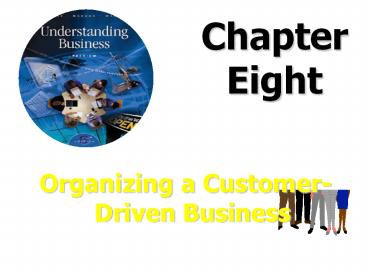Chapter Eight - PowerPoint PPT Presentation
Title:
Chapter Eight
Description:
Don't tell off-color jokes or use profane language among group members. ... Everyone is to be clean/organized at the workstation. ... – PowerPoint PPT presentation
Number of Views:84
Avg rating:3.0/5.0
Title: Chapter Eight
1
Chapter Eight
Organizing a Customer-Driven Business
2
Management Pyramid
CEO, Comptroller, Vice Pres.
Top
Sales Mgrs Plant Mgrs.
Mid-Level
Supervisors Foremen
Front Line/Supervisory
3
Workers in Large Companies During the Last 5
Years Have Undergone...
500 Employees
Source Gallup for Carlson Marketing Group
4
Purpose of an Organizational Chart
- Show the activities of the organization
- Highlight subdivisions of the organization
- Identify different types of work performed
- Provide information about different management
levels - Show the lines of authority in the organization
and the flow of organizational communications
5
Organizational Design
- Organization
- Division
- Department
- Group
- Individual
6
Fayols Principles of Organization
- Degree of Centralization
- Communication Channels
- Order
- Equity
- Esprit de Corps
- Unity of Command
- Hierarchy of Authority
- Division of Labor
- Subordination of Individual Interest
- Authority
7
Webers Organizational Principles
- Job Descriptions
- Written Rules
- Procedures, Regulations, Policies
- Staffing/Promotions based on Qualifications
8
Fundamentals of Bureaucracy
- Chain of Command
- Rules Regulations
- Set Up by Function
- Communication Minimal
9
Organizational Structures
- Tall Organizations
- Many Layers of Mgmt.
- Cost of Mgmt.High
- Flat Organizations
- Current Trend
- Creation of Teams
10
Span of Control
- Capabilities of Subordinates Manager
- Complexity of Job
- Geographically Close
- Functional Similarity
- Need for Coordination
- Planning Demands
- Functional Complexity
11
Departmentalization
- Advantages
- Skill Development
- Economies of Scale
- Good Coordination
12
Departmentalization
- Disadvantages
- Lack of Communication
- Employees Identify with Department
- Slow Response to External Demands
- Narrow Specialists
13
Departmentalization
- Product
- Function
- Customer
- Location
- Process
14
Centralization (No Delegation)
- Disadvantages
- Lots of Policies Procedures
- Many Layers/Slower
- Advantages
- Increased Uniformity
- Less Duplication
- Maximum Control
15
Decentralization (Delegate Authority)
- Advantages
- Informed Decisions
- Worker Responsibility
- Few Layers/Faster
- Disadvantages
- Loss of Control
- Possible Duplication
16
Line Organizations
- Advantages
- Clear Authority Responsibility
- Easy to Understand
- One Supervisor per Employee
- Disadvantages
- Inflexible
- Few Specialists for Advice
- Long Line of Communication
- Difficult to Handle Complex Decisions
17
Layers of Authority
- Top Managers- Decision Makers
- Middle Managers- Developed Rules Procedures
- Workers and Supervisors
18
Line/Staff Organizations
- Line Personnel
- Perform Functions
- Contribute Directly to Organizational Goals
- Staff Personnel
- Advise
- Assist Line Personnel
19
Matrix Organizations
- Advantages
- Flexibility
- Cooperation Teamwork
- Creativity
- More Efficient Use of Resources
- Disadvantages
- Costly/Complex
- Confusion in Loyalty
- Requires Good Interpersonal Skills Cooperation
- Not Permanent
20
Tips for Team Leaders
- Dont be afraid to admit ignorance
- Know when to intervene
- Learn to truly share power
- Worry about what you take on, not what you give
up - Get used to learning on the job
21
Networking Nets
- Networking
- Real Time
- Transparency
- Nets
- Extranet
- Intranet
Teleconference
22
A Virtual Corporation (Figure 8.7)
Production Firm
Distribution Firm
Accounting Firm
Core Firm
Legal Firm
Advertising Agency
Design Firm
23
The Four Rs ofOrganizational Transformation
- Reframe
- Restructure
- Revitalize
- Renew
24
How to ImproveOrganizational Structure
- Break business into smaller units
- Build teamwork
- Impose autonomy
- Create meaningful incentives
- Outsource non-operating activities
- Share business capabilities across units
25
Inverted Organization Structure
Empowered front-line workers
Support Personnel
Top Mgmt.
26
Outsourcing
Benefits
Downside
- Time to focus on companys primary function
- Increased level of expertise
- Cost effectiveness
- Decreased overhead
- Risk reduction
- Flexibility
- Technology
- Less personal approach
- Less control by owner in planning, implementing
carrying out companys future - Potential for competing for the outsourcing
firms time
27
Customer -Focused Design
- Bottom-up relationships
- Outsource
- Global orientation
- Internal vs. external customers
- Information
- Build teamwork
- cross-functional
- integration
- Self-management autonomy
28
Examples ofInformal Group Norms
- Do your job but dont produce more than the rest
of the group. - Dont tell off-color jokes or use profane
language among group members. - Listen to the boss and use his/her expertise but
dont trust him/her. - Everyone is to be clean/organized at the
workstation.
29
Examples ofInformal Group Norms(contd)
- Never side with managers in a dispute involving
group members. - Respect/help your fellow group members on the
job. - Criticize the organization only among group
members- never among strangers. - Drinking is done off-the-job. Never at work!
30
Key Terms
- Bureaucracy 236
- Centralized authority 244
- Continuous improvement 251
- Cross functional teams 248
- Decentralized authority 244
- Departmentalization 241
- Formal organization 255
- Informal organization 255
- Inverted organization 252
- Line personnel 245
- Matrix organization 246
- Networking 249
- Organizational culture 254
- Organizational design 236
- Outsourcing 254
- Reengineering 252
- Restructuring 238
- Span of control 239
- Staff personnel 249
- Total quality management 251































